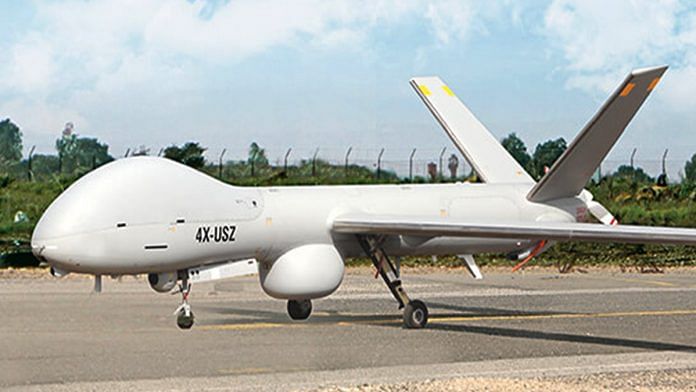New Delhi: The Indian Navy Wednesday took delivery of its first India-made Medium Altitude Long Endurance (MALE) drone, acquired under emergency procurement mechanism, to augment India’s ability to keep a close eye on the waters of the Indian Ocean.
Manufactured by Adani Defence and Aerospace in partnership with the Israeli firm Elbit, in Hyderabad, the Drishti 10 StarLiner, with an endurance of 36 hours, satellite connectivity and the ability to carry a payload of 450 kg, is the Indian version of the original Hermes StarLiner.
Navy chief Admiral R. Hari Kumar, who took the delivery of the first Drishti 10 Starliner Wednesday, said: “True to its name, (the drone) has seen the light of the day in just ‘10 months’ post the conclusion of the contract.”
The UAV will fly from Hyderabad to Porbandar in Gujarat to be pressed into naval maritime operations.
Both the Navy and the Army have gone in for two drones each, with a service ceiling of 30,000 feet, under emergency procurement which allows them to bypass tardy bureaucratic procedures for deals up to Rs 300 crore.
Asked about the indigenous content on the drone, sources involved with the project said that it stood at 70 percent and the company plans to scale it up.
ThePrint first reported how Adani Group in January 2019 wrote to the defence ministry to offer its Hermes 900 UAV under the Indigenously Designed Developed and Manufactured (IDDM) category of the Defence Procurement Procedure — which allows equipment with 40 or 60 percent indigenous content to be considered for acquisition.
While only four of these UAVs have been ordered for now, the military is looking at acquiring about 150 MALE drones.
“Indian Navy and Indian Army have placed orders for two each of these Drishti-10 drones to meet our emergent requirement for satellite communication-enabled drones,” Lt Gen Ajay Suri, Director-General of Army Aviation, said at the event in Hyderabad Wednesday.
Underlining the importance of drones in modern warfare, Admiral Kumar said autonomous systems are becoming a preferred choice in the ‘order of battle’ for countries across the globe.
“Both our immediate neighbours collectively hold a very large inventory of UAVs. Therefore, it is only prudent that we, as a nation, and as armed forces, continue to harness our resident expertise in this domain, by remaining agile, adaptable and ahead of the curve,” he said.
The navy chief, meanwhile, added that with state-of-the-art sensors, enhanced endurance, advanced communication capabilities as well as new-age technologies like automatic take-off and landing (ATOL), Drishti would be a potent force multiplier, adding more capability and credibility to Intelligence, Surveillance and Reconnaissance (ISR) missions across the Indian Ocean region.
He added that, additionally, the versatility and flexibility offered through modularity and mobility of ground support equipment would enable us to operate it from any naval air stations across “Bharat”.
The drone is qualified for flight in civilian non-segregated airspace and in adverse weather conditions thanks to its unique and unlimited deicing mechanism. According to the company, the drone also has Starliner features over-the-horizon, persistent multi-mission, multi-sensor capabilities with a class-leading payload carrying capacity.
The Navy currently operates tactical drones in addition to the four High Altitude Long Endurance (HALE) drones called ‘Sea Guardians’.
The Army, which has procured a number of drones of varying capabilities, has already bought four Satellite Communication-enabled Israeli Heron Mark-II drones. The Indian military plans to upgrade the existing fleet of Heron Mark-I with similar capabilities that will allow it to operate them with longer endurance and capabilities, as reported earlier.
The Herons currently have an endurance of about 24 hours and can transmit back live video feed and images within a range of about 200-250 km. With satellite-link, they will have almost unlimited range of transmission and can be fully exploited to their endurance capabilities.
While it was earlier planning to arm these upgraded drones in the next phase, the idea was later dropped, as reported first by ThePrint.
Meanwhile, the Army, Navy and the Air Force are looking at the acquisition of 31 HALE (MQ-9B) drones which will be inducted into the Indian military over the next three-four years. Of the 31, Navy will get 15 MQ-9B drones in maritime and anti-submarine warfare kits, while the Army and the Indian Air Force (IAF) will get eight each of the land version.
(Edited by Amrtansh Arora)
Also Read: Hyderabad firm develops AI-powered system to counter hostile drones, takes it to armed forces



